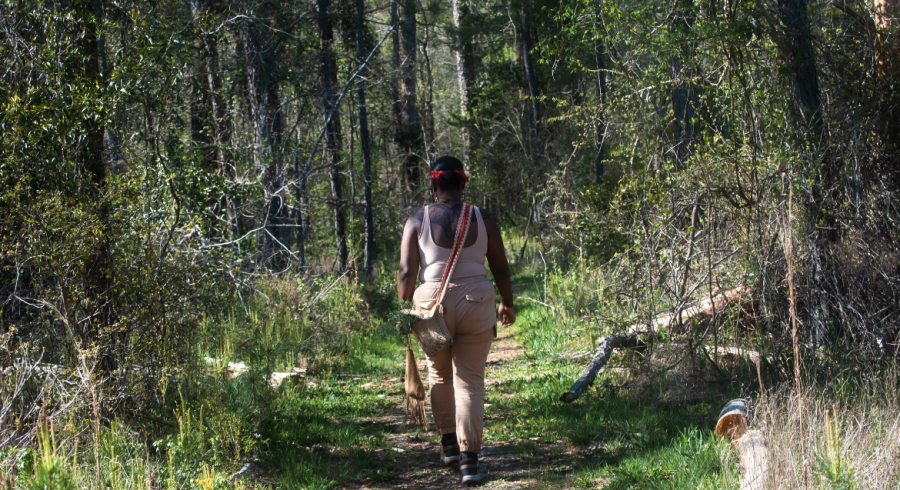From lacrosse to the blanket toss, sports in native traditions have evolved and endured. Whether their origins are spiritual, survival, or entertainment based, sports have always played and continue to play an important role in Native American culture. In the past, sports activities were used to develop strength, agility, and coordination, skills that could help the people be effective providers and caretakers. Different versions of the hoop and pole game played by the Zuni, Hopi, Sioux, and Cheyenne demonstrate the role games played in skill development. A hoop with an inner web-like mesh is rolled along the ground. An attempt is made by the players-usually boys or men-to pierce it with a spear or an arrow shot from a bow. Thus, by playing the game, they sharpened their aim and hunting skills.
Another traditional game, lacrosse, originated in the Iroquois Confederacy Lacrosse sticks were made out of saplings and the balls were made of wood. There were sometimes hundreds of players to a team, and the field of play often extended for miles. The objective of the game was the same as it is today: to get your ball in the opponent's goal. Not only did lacrosse provide a means to challenge oneself physically-it was nicknamed the "little brother of war"-it was also considered a gift from the Creator, played for various spiritual reasons, and used to heal the sick.
Various ceremonial rituals such as abstinence and special dieting went along with lacrosse and its variations. The Cherokee did not eat certain foods such as the meat of the timid rabbit, the meat of the weak-boned frog, or the meat of other slow-moving animals. Lacrosse has evolved over time, as have the ceremonial rituals that go along with the game. Now, some Iroquois players do not allow a woman to touch their lacrosse stick. Perhaps it is because women are believed to have a power that men do not have, or perhaps the stick is sacred; whatever the reason, there remains a strong spiritual aspect to the game of lacrosse.
Aluminum sticks, synthetic balls, and official rules now govern the game. There is a professional indoor lacrosse league (composed of natives and non-natives), and the Iroquois National team is composed of representatives from all six tribes of the Iroquois Confederacy. This team has played in World Cup games against other nations such as the United States and Japan. The existence of the Iroquois National team is just one example of a modem day initiative to retain traditional sports and games as part of the culture of native people.
In 1994, the Native American Sports Council (NASC) was formed to establish youth sports programs that promote "wellness" in Native American communities and to identify and support promising athletes who have the chance to compete internationally This organization was formally welcomed into the United States Olympic Committee (USOC) during a ceremony in November, 1994. Previously, Natives were so marginalized in international sports, the idea was entertained to have Native America compete as a separate nation from the U.S. Since becoming a part of the USOC, promising native athletes are allowed to train at the Olympic centers in Colorado Springs, Lake Placid, and San Diego. Also, the NASC will gain a seat on the USOC's Board of Directors and have access to their wealth of knowledge in marketing and fund-raising. The committee provides living stipends, plane tickets, and occasionally, necessary equipment to native athletes who are in need of support to realize their dreams.
North American Indigenous Games
In addition to the formal arrival of Native America on the Olympic scene, natives have been participating in an "Olympics" of their own. The North American Indigenous Games (NAIG) began in 1990 in Edmonton, Alberta with 3,000 athletes in attendance. The Games have since been held in Prince Albert, Saskatchewan in 1993, and in Blaine, Minnesota in 1995. The games are held every two years and the number of athletes has grown to 8,000 with nearly an equal number of volunteers. Tribes organize by state, province, or territory and enter the Games together as a team. NAIG are governed by a council consisting of 13 mandated representatives from Canada and 13 representatives from the U.S. The Council is responsible for establishing the philosophy, objectives, and rules of the Games; policies and procedures to guide the preparation and staging of the Games; ensuring that the Games play an important role in Aboriginal sports development; and determining the site of future Games.
The 1995 Indigenous Games were an event of a lifetime for Narragansett tribal member and member of Team Connecticut, Teah Hopkins. "The Games were something we could call our own. Native Americans of all ages were competing, not just against each other, but for themselves, and everyone was on an equal level. When we walked in together during the opening ceremonies, I couldn't believe how many natives were there. There were thousands of people! There was a great sense of family belonging, everyone would just go up to each other and introduce themselves with such openness and familiarity. You could definitely feel that people were taking with them a renewed spirit and an increased sense of pride from participating in the Games."
The 1997 Games will be held in Victoria, British Columbia, August 3-10. It will be the largest indigenous Games in North America with teams representing the provinces, states, and territories of the United States and Canada. Support for the Indigenous Games 1997, with a budget of $4.4 million, comes from the Canadian Government, the Province of British Columbia, and corporate partnerships. Aside from the athletic competition, the indigenous Games will celebrate the survival of the many native cultures participating in the games.
The Sacred Run will take place with participants carrying the Sacred Bundle (prepared in consultation with tribal elders) from the past sites of the Games to this year's site in Victoria. The run and transport of this bundle are an integral part of the Indigenous Games and represent the strong link between all native peoples. There will also be a colorful parade of athletes and Nations at the Opening Ceremonies. The Sacred Bundle and Sacred Lance will officially be presented. Also incorporated in the Opening Ceremonies will be a presentation of sports that demonstrate and reinforce the sacredness of the number four (four cardinal directions) in the traditional Native way of life. The First Nations Cultural Village, a focal point of the games, includes an arts and crafts area with hundreds of vendors and artists. An outdoor amphitheater will house daily entertainment and other events for the thousands of spectators.
Perhaps the most remarkable aspect of the 1997 Indigenous Games will be the sea-faring journey of hundreds of canoes that will travel to victoria from all parts of the North American coast. They will be welcomed in Victoria's inner harbor in a re-creation of a Coast Salish tradition whereby warriors will be sent into the inner harbor in giant cedar canoes to greet the visiting indigenous nations and escort them to shore. Although this ceremony will conjure up images of the beauty to be held at these Games, the most noteworthy aspect will be what they represent. The Games will be a celebration indigenous people, life, culture, and history making a statement of strength, courage, and survival. With the will of the Creator, native people will continue to gather in such celebrations forever.
Article copyright Cultural Survival, Inc.



